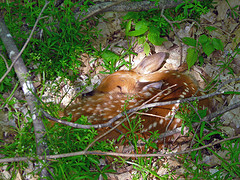Urban Wildlife Damage Abatement and Control Grant

Newborn fawn concealed by foliage.
Urban Wildlife Damage Abatement and Control (UWDAC) grants help urban areas develop wildlife plans, implement specific damage abatement and/or control measures for white-tailed deer and/or Canada geese. They are available to any town, city or village in an urban area.
This grant provides a 50% cost share up to $5,000.00 for eligible costs.
The grant application period opens on Oct 1st each year.
The application deadline is Dec 1st each year.
Who can apply
Who can apply? Per NEW state statutory definition, any city, village, or town with a population density of not less than 125 persons per square mile is eligible to apply. If you are uncertain if your governmental unit falls within this definition, please check the US Census Bureau website.
Eligibility
Eligible projects
- Developing an urban wildlife population control plan.
- Monitoring wildlife populations and establishing population estimates.
- Removing deer using sharpshooters as part of a DNR approved project.
- Trapping deer and geese.
- Implementing managed hunts.
- Removing resident Canada geese by approved DNR methods.
- Performing required health and tissue sampling.
- Processing, distributing or disposing of geese or deer to a charitable organization.
- Modifying habitat.
- Implementing any other wildlife control or damage abatement practices approved by the DNR.
Please contact wildlife damage staff if you have questions about developing a plan, population monitoring, control methods, etc.
Deadlines
The grant application period opens on Oct 1st each year.
The application deadline is Dec 1st each year.
Grant awards are issued in January of the grant year.
Ranking
The following criteria will be used to rank applications for grant awards:
- the extent that the application addresses prevention and abatement of nuisance wildlife problems or wildlife damage to human safety, health, property;
- the extent that the application includes long-term solutions to wildlife problems such as habitat modification or adopting a "no wildlife feeding" ordinance;
- the cost-effectiveness of the plan or project;
- the severity of the wildlife damage or nuisance problem addressed by the application; and
- the likelihood of preventing the specified damage or nuisance.
Laws
Grant related statutes and administrative codes
Contact
Contact information
For more information, contact:
Wendy Soleska
Grant Manager
608-852-1358Wildlife Damage and Nuisance Staff
Wildlife Management
